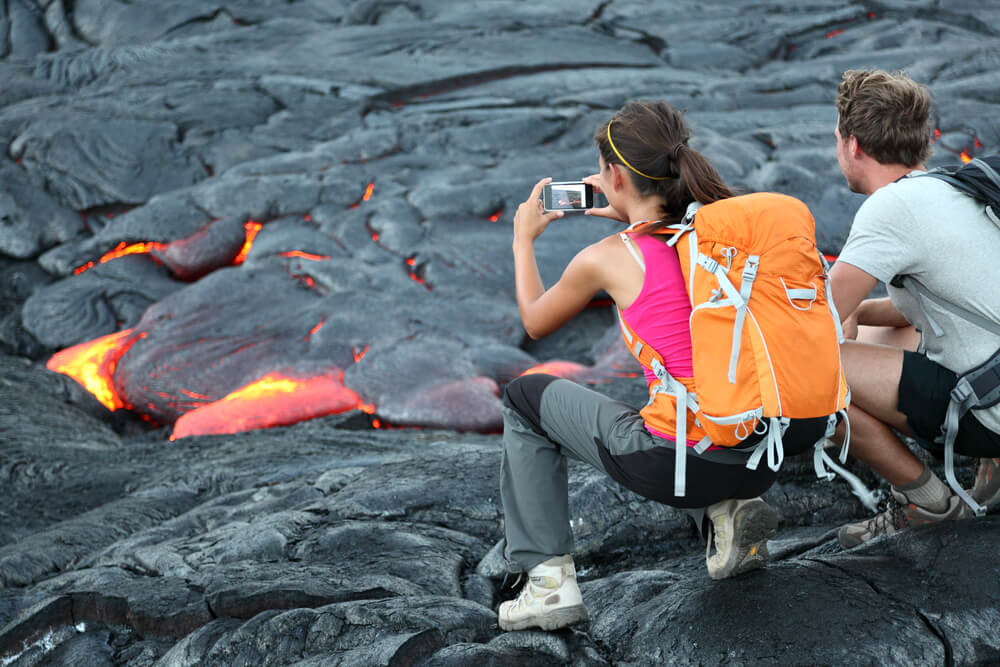Heading to the Big Island and hope to see real lava on your Hawaiian vacation? Scroll to find out everything you you need to know in this guide to Hawaii Volcanoes National Park, the only UNESCO World Heritage Site in Hawaii.
This Guide to Hawaii Volcanoes National Park was written by Hawaii travel expert Marcie Cheung and contains affiliate links which means if you purchase something from one of my affiliate links, I may earn a small commission that goes back into maintaining this blog.
Believe it or not, the island of Hawaii, also known as the Big Island is a new island and is constantly growing. The growth is all due to the hot spot that has continuously spewed lava into the ocean.
It’s also one of the few places in the world where regular people can hike to the active lava spots and get amazing photographs of the lava flowing into the ocean.
But the lava isn’t the only thing you can do here at Big Island Volcano Park. There are tons of things to do in Volcanoes National Park if you have the time.
So How much time do you need at Volcano National Park? There is no easy answer to this question. It all depends on how much time you have.
There are several activities you can do that allow you to get a brief glimpse of what the park has. Or, you can spend days exploring every inch of the Hawaii National Volcano Park.
So, whether you are doing a day trip to Hawaii Volcanoes National Park or are planning on spending several days there, this Volcanoes National Park guide has you covered!
First trip to the Big Island? Read THIS first!
Don’t have time to read many Hawaii blog posts and reviews? Here are some of our top picks for visiting the Big Island.
Popular Big Island Tours/Activities
- Manta Ray Snorkeling Tour (you can ONLY do this on the Big Island)
- Hawaii Volcanoes National Park Tour (this is the BEST way to see lava if you aren’t renting a car)
- Mauna Kea Stargazing Tour (this is a cool adventure for teens and adults)
- Swim with Dolphins (this is a unique experience for kids of all ages and adults)
- Kona ATV Tour (we love this one because they also do cultural activities)
- Book a Photo Shoot (this is a Hawaii souvenir you’ll treasure forever)
Favorite Big Island Resorts/Hotels
- Hilton Waikoloa Village (this is a mega resort where you can swim with dolphins or just enjoy their massive pool area)
- Courtyard by Marriott’s King Kamehameha Beach Hotel (this is a moderately-priced Kona hotel right on a little lagoon)
- Fairmont Orchid (this is a swanky resort with an awesome pool area and beach)
Want to Rent a Car in Hawaii?
One of the best places to rent a car in Hawaii is Discount Hawaii Car Rental because they get the best rates from top national companies like Alamo, Dollar, Thrifty, Avis, Enterprise, Budget, and Payless.
Want to skip all the planning and just access my detailed Big Island Itinerary, complete with daily schedules, kid-friendly activities, and travel hacks? Click the button below.
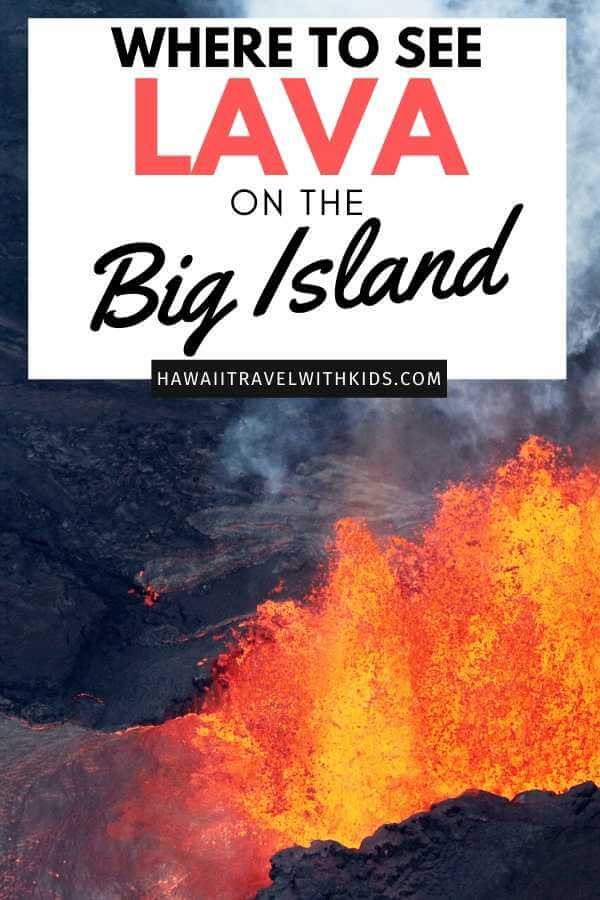
The Ultimate Guide to Hawaii Volcanoes National Park
Here is your Volcano National Park guide to learn all there is to see and do here along with how to get to Volcano National Park.
Where is Volcano National Park located?
Before you can start planning on what to see and do at the park, you need to know where to go. The Hawaii Volcanoes National Park is located on the south side of the Big Island between Hilo and Kona.
Starting in Kona — Fastest Way
If you are starting out on the Kona side of the island, or the “dry” side, you will have to take Highway 11. Start by going southeast, you’ll cut through Kealakekua, Captain Cook, South Point, Na’alehu, and Pahala.
Don’t just drive through these areas, there are tons of things to see. You can stop and enjoy the black sand beach that is located on the Ka’u Coast. Look for signs for Punalu’u.
Have a picnic and enjoy the basking turtles for a bit before heading back on the road.
Then you can simply continue driving around Highway 11 until you reach the Hawaii Volcanoes National Park.
In total, the drive from Kona to Volcano National Park is about 2 and a half hours and is 96 miles if you are going to the park from the Kona side of the island. This is of course taking the shortest route.
Starting in Kona — Alternative Route
Another option is to start from Kona and go through to Waikoloa. From Waikoloa, you’ll head up to Waimea. You can take the ‘shortcut’ through the dormant volcanoes of Mauna Loa and Mauna Kea on “Saddle Road.”
Saddle Road isn’t as bad as it once was. It used to have blind turns and very windy roads with limited visibility.
But over the years, the state has made improvements to the road, and it’s an easy smooth drive to get to the Hilo side of the island.
If you take this route, you’ll be amazed by old Lehua forests and see just how massive Mauna Loa and Mauna Kea are.
This route will take about 2 and a half hours to get to the Hawaii Volcanoes National Park. It doesn’t have a view of the coast, but the view is still pretty awesome cutting through the sleeping volcanoes.
Starting in Kona — Alternative Route 2
Or, you can go from Waikoloa to Waimea and continue around through Laupāhoehoe, and see the stunning coastline with this route.
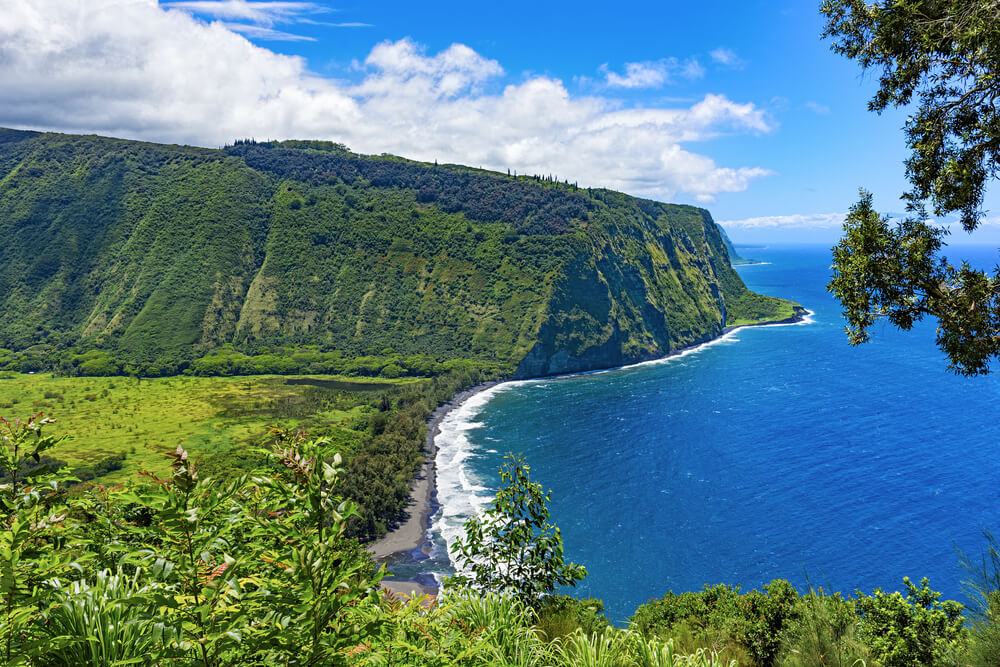
If you take this route, don’t forget to take a detour to Waipio Valley lookout in Honoka’a. There you will see an amazing view of a black sand beach and glorious valleys.
It was here that Water World was filmed for the land scenes.
Word of caution though, don’t try to go down to the beach. Just enjoy the lookout.
The hike down is easy and you may think you have the time to go down and back up. But the climb back up is what will take the most time.
The road is super steep and it switches back again and again. It takes ten minutes to climb down, but at least 35 to get back up. It is not an easy climb to the top. However, you can do the Waipio Valley Shuttle tour, which is awesome!
But, if you want to hike, then jump back in your car and cruise to Laupāhoehoe where you’ll find the Akaka Falls.
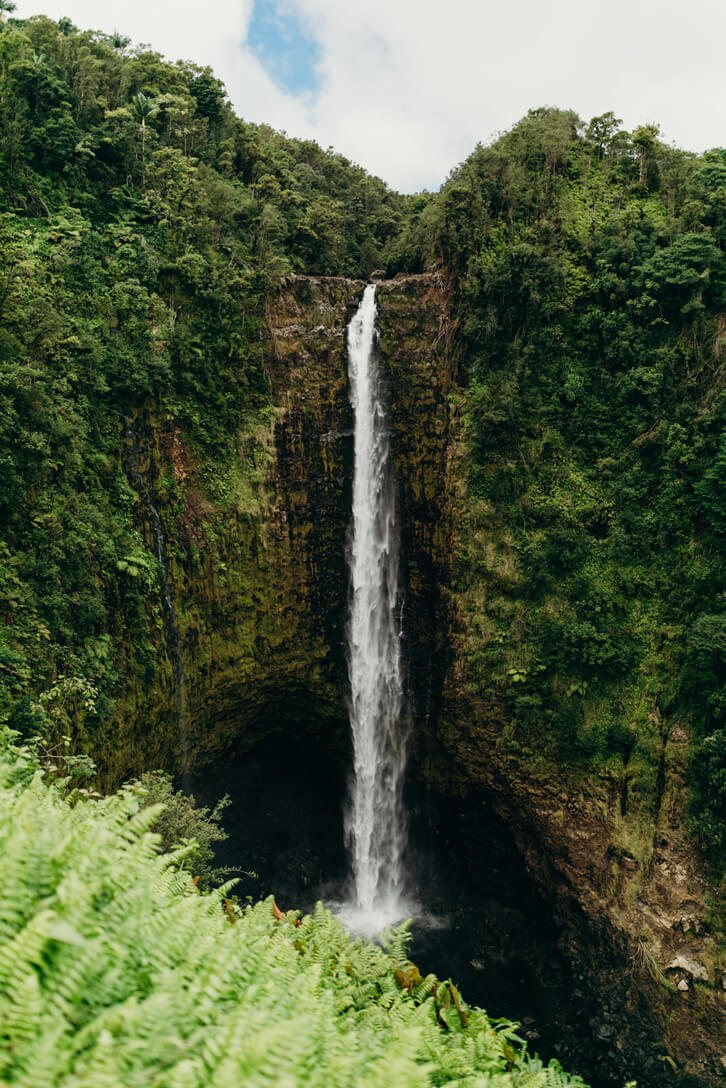
Here you’ll hike through the rainforest and find a spectacular waterfall. The path to the waterfall is easy and maintained. It takes about 20 minutes for a round-trip hike to see the falls.
Cutting through Hilo or Starting in Hilo
Once your legs are stretched, continue on Highway 19 and connect with Highway 11. You’ll be cutting through Hilo on this route and get to see the Banyan trees on the main strip, and also Hilo bay.
This route will take you around 2.5 to 4 hours depending on if you stop to hike, or if you stop at each point before getting to the Volcano National Park.
However, if you are staying in Hilo, you’ll find the park is a mere 30 miles southwest. Simply drive for 45 minutes through Hilo and you’ll come across the park.
Cost of Admission to the Hawaii Volcanoes National Park
Unfortunately, there is a cost to get into the park, but at least it isn’t too bad. Since 1987, the park has charged per vehicle. For cars, there is a $30 entrance fee. For motorcycles, it is $25.
But, there are so many things to see and do here with the Hawaiian volcanoes, that the price is well worth it.
Best Things to Do at Big Island Volcano National Park
When you first drive through the entrance of the Hawaii Volcano National Park, you may find yourself on a foreign planet. At least, that will be what it seems like.
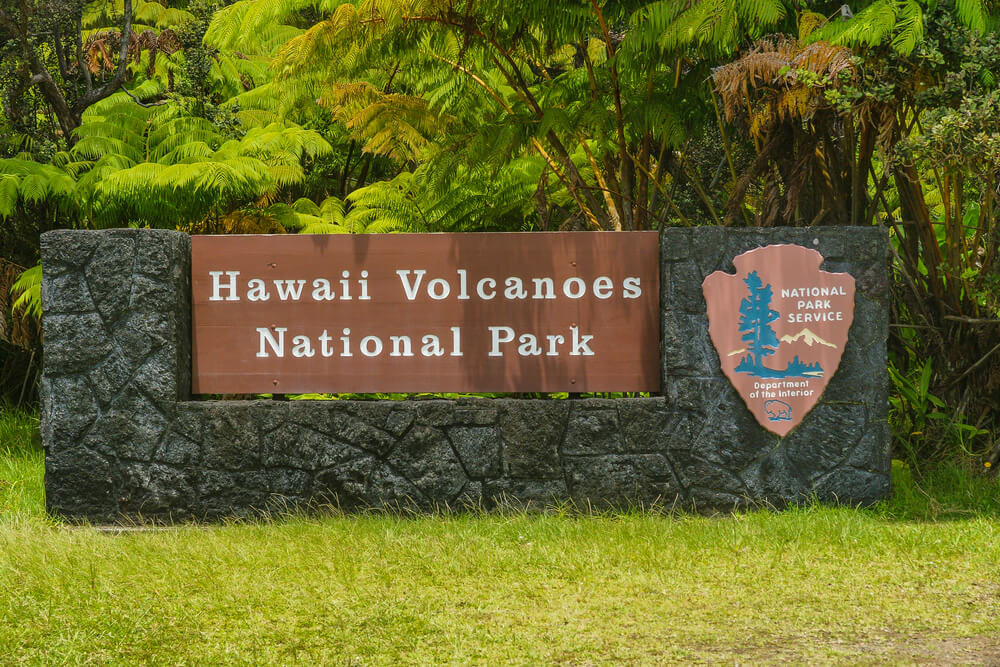
The vast dark ragged and rugged landscape makes it look like you are someplace other than Earth. And you may wonder what all you can do here at the park.
Well, there are tons of things for you to see and do at this UNESCO World Heritage Site.
You’ll first want to get an idea of what is around you. Stopping at the kīlauea visitor center should be your first priority.
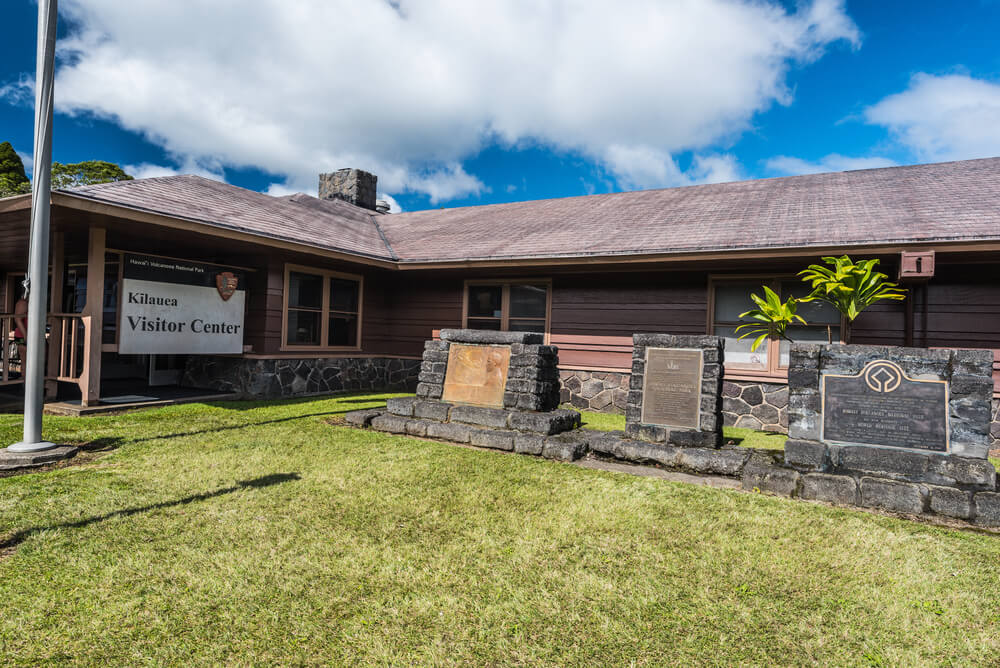
It is here that you’ll learn about the different types of lava flows. You will also get to see the different advancements scientists are making to explore and better understand lava and the earth’s core. They have all the Hawaii Volcano National Park facts.
Once you roam around the museum and snag a map of the park, you might want to jump right into actually seeing lava flow out into the ocean. The thing is though you are still a ways away from the shore.
In fact, it will take about 45 minutes to travel down the road to get to the place where you can park and then another 30-minute hike to the coastline over frozen lava fields.
So, you might want to wait and do this last for 2 reasons.
First, there is a lot to see and do between the visitor center and the shoreline. Just making a beeline to the flowing lava will have you missing out on some amazing sites.
Second, viewing the lava lake at dusk is far more stunning than watching it during daylight hours. Normally the glowing light is visible during the day. To get that remarkable and unforgettable view, wait till dusk.
Thurston Lava Tube
The Thurston Lava Tube is one of the more popular sights to see at Hawaii Volcanoes National Park.
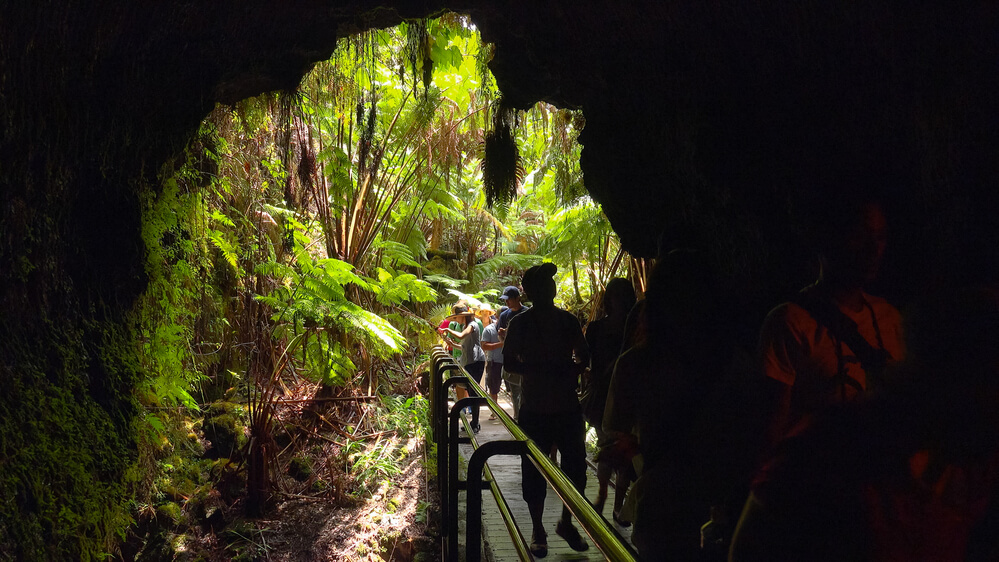
It is a spot where lava passed through clean leaving an open area for you to walk through. It’s basically a cave that anyone can walk through. The ground is flat, and it goes on a short distance and is a must-see.
Crater Rim Road
The Crater Rim is the fastest and easiest way to see a lot in a short amount of time. Of course, short is relative seeing as there are so many spots to stop and take in the view, have a picnic, or just relax and enjoy nature.
But if you are on a time limit, then doing the Crater Rim Drive or the Crater Rim Trail will give you the most photo opportunities for your time.
First, you’ll start out at the visitor’s center and drive around to the Steam vents. There you will also be able to take in the Steaming Bluff and Ha’akulamanu.
Just be wary of the stench around the Ha’akulamanu sulphur banks trail.
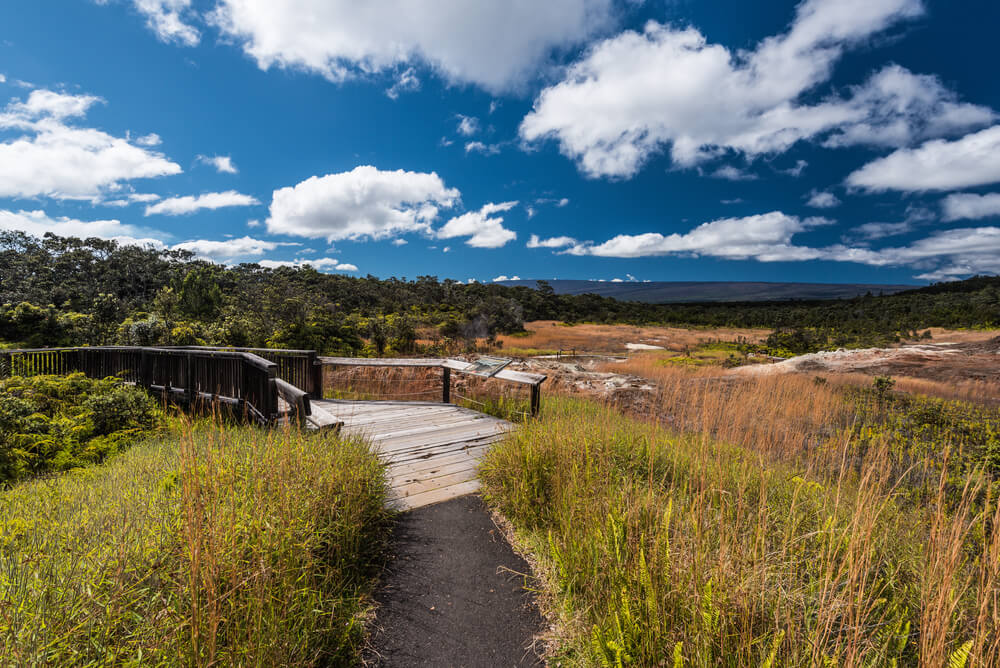
The steam vents and bluff are around the Sulphur Banks area which means that the air quality will be poor and will stink of rotten eggs because that is what sulfur smells like.
Once you get your pictures, continue on the drive and stop off at the Kilauea Iki Overlook. The view here is fantastic and wonderful. There are plenty of places on the side of the road to stop for a picnic or enjoy the scenery.
Then it’s off to the Pu’u Pua’i Overlook where you can see even more awesomeness of how lava can transform and create new land.
Once you have seen the valley area, you can head towards the “Devastation Trail” and stretch your legs on a small hike.
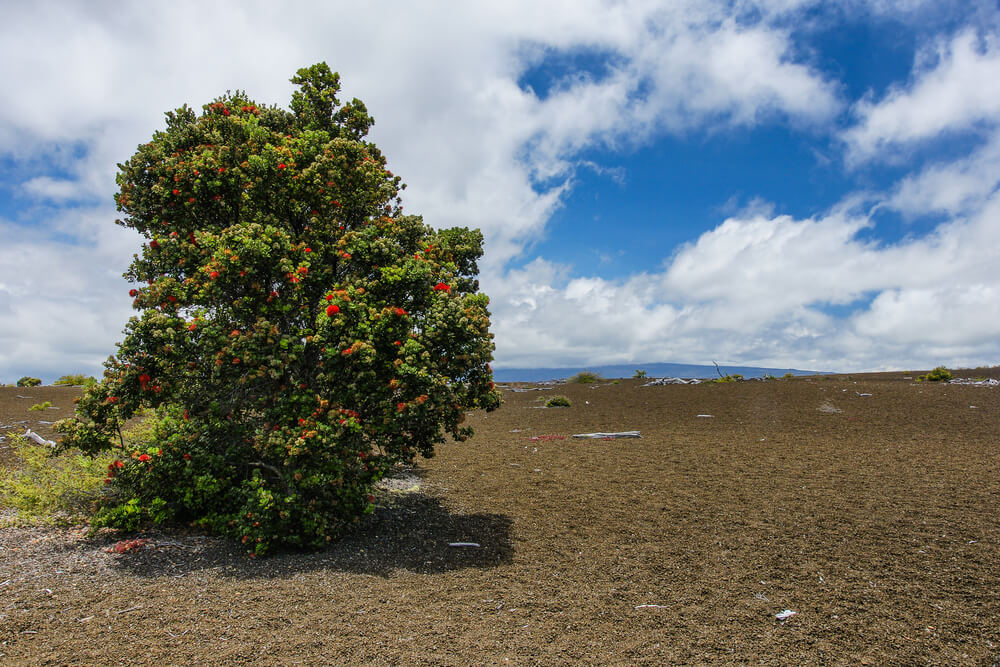
The Devastation Trail makes it seem like you are on the moon or even Mars. There are no trees or anything around and looks just as it sounds. Barren and devoid of life.
Finally, the Crater Rim Drive will take you to Keanakako’i Crater. Once you have got your fill of the Crater Rim, you can start the long drive down the Chain of Craters Road.
Here you will find lots to see, from old lava rivers that are dated along the road to views of the Pacific Ocean.
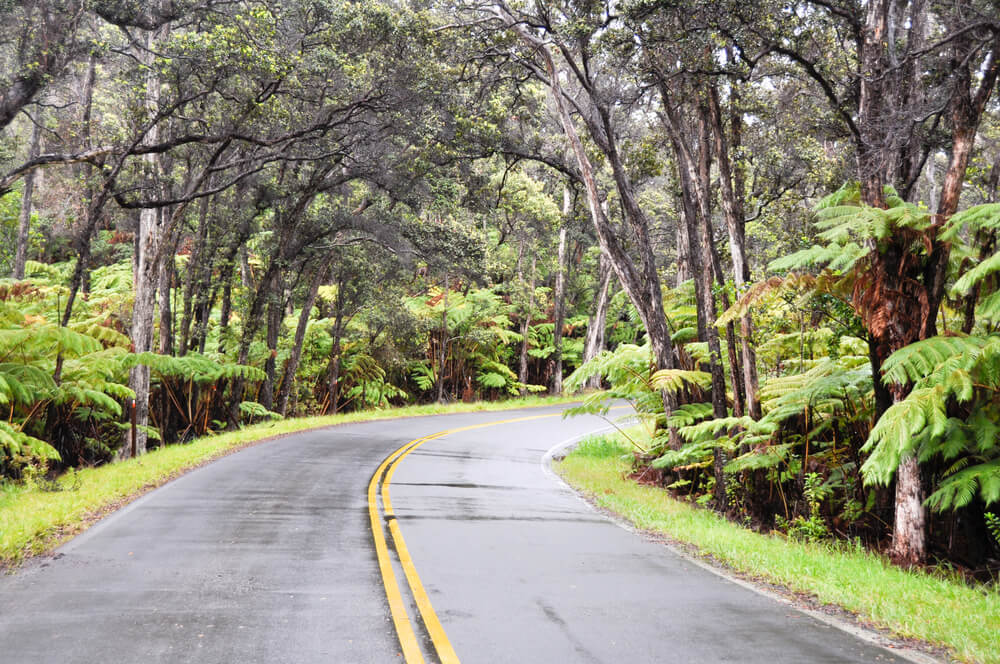
The Chain of Craters Road will bring you down the slopes of Kilauea towards the ocean. Here you can check out the Holei Sea Arch at the end of the road. It is here that you really understand and see that the Big Island is a new island and growing.
Hiking Trails in National Volcano Park
There are tons of hikes to enjoy while visiting Kilauea volcano. Some are short and others take longer.
The Kilauea Iki Crater hike is about 2 to 3 hours and is quite popular. The Kilauea Iki Crater trail can be challenging, so it’s probably not the one you want to do with kids.
The Crater Rim Trail, sulphur banks, the Kilauea Caldera hike, and Kīpukapuaulu are other fun hikes to see more parts of this large park.
Volcano Art Center Gallery
If you want to explore some of the most gorgeous art of the hot lava and volcanoes, check out the Volcano Art Center gallery while you are at the park.
You can also explore more at Volcano Village as well.
Special Ranger Programs at Hawaii Volcanoes National Park
There are some really cool programs at this Hawaii National Park that are offered throughout the year.
On select Tuesdays, head to the Kilauea Visitor Center for After Dark In The Park for special presentations by leading scientists, artists, and cultural experts on park-related topics.
Join Hawaiian practitioners as they share the arts and culture of Hawaiʻi with demonstrations and hands-on activities during ʻIke Hana Noʻeau (which translates to “Experience the skillful work”.)
Grab tickets for a small, underground laboratory where you’ll experience A Walk Into The Past – A Living History.
This is where a living history presenter dressed in period costume brings back to life Thomas A. Jaggar, founder of Hawaiian Volcano Observatory.
Find out which programs are happening during your trip
Camping at Hawaii Volcanoes National Park
The Hawaii Volcanoes National Park is a lot bigger than what people think. You can spend days here and still not see everything. That is why the park offers people the ability to camp in the park.
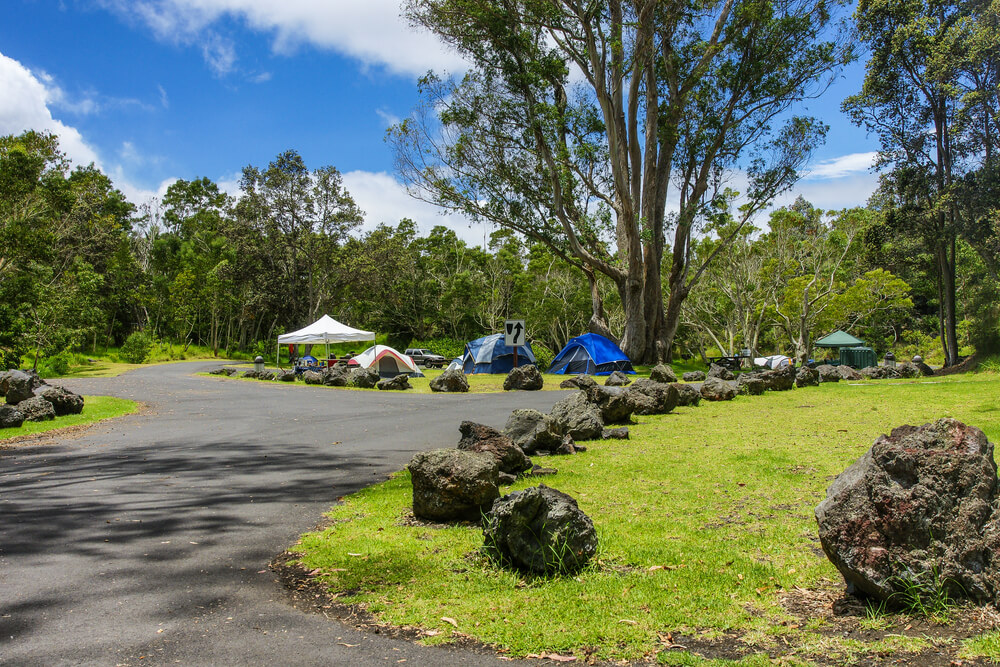
Granted, you’ll have to get a pass and talk to the rangers at the visitor center to know what part of the park is closed off to campers and hikers.
But if you have time to kill, camping at Volcano National Park and exploring the park as the Hawaiians once did make it a memorable experience for sure. It is the best way to see Volcano National Park.
As for hiking, there are tons of trails you can go on. Each trail is different and some are harder than others.
There is one trail that takes you over the crater and takes several hours to complete or one that brings you through a rain forest where you can search for the Hawaii State bird, the Nene Goose. It all depends on your level of exercise.
Just be sure to bring plenty of food and water while experiencing the park.
Find out more about Camping in Hawaii
What to Bring to Hawaii Volcanoes National Park
When viewing the lava at Halema’uma’u Crater on the slopes of Kilauea, there are a few things you need to do it safely. Wear sturdy closed-toe shoes. Lava is unforgiving and one slip or stumble and the lava rocks will cut into you very easily.
You should also have with you plenty of water. There are so many people who get lost on the trail coming back to their car and are without water that it is scary. So just make sure you have water with you at all times.
A flashlight is a must if you are going to see the lava at dusk. You’ll lose track of time down there watching the lava spewing into the ocean and you’ll need a light to find the trail to get back to the car. Find the best prices here.
Flashlights are inexpensive and can save your life out there.
Far too many people get turned around in the open lava field and lose track of where they are going without a light.
Many wonder what to wear to Hawaii Volcano National Park and I always say you’ll need a good jacket or wind breaker. The temperature drops at night in the park. It also has a tendency to rain in the evening in Hilo. Check out the latest prices and more details.
Granted, Hawaii temperature doesn’t drop like you would see in the deserts of say Arizona, but it does get chilly. It can even drop down to the high 40s or low 50s. In this case, it can be quite cold and damp. So bring a jacket while visiting the park.
Where to Stay Near Hawaii Volcanoes National Park
If you think you’ll want to spend more than one day exploring this Hawaii National Park, you might consider staying nearby. There is one hotel, many vacation rental homes, and even cool Hawaii treehouses worth a stay.
Volcano House
If you want to stay in a Hawaii Volcanoes National Park hotel, Volcano House is the only hotel located within the park. It first opened in 1846 and sits on the rim of Kilauea’s Halemaumau crater. Read my full review HERE.
People come from all over the world to experience its iconic location, rich cultural legacy, and warm Hawaiian hospitality. If you are planning a Volcanoes National Park vacation, you’ll definitely want to stay at the Volcano House Hotel. Check out the latest prices and more details.
Lava Lodge at Volcano Village
Just one mile from the entrance to Hawaii Volcanoes National Park is Volcano Village, in the old Ohi’a lush rainforest. You can easily walk to popular Volcano restaurants and shops. Check out the latest prices and more details.
Treehouse Cottage at Kilauea Volcano
For a really epic experience, stay at a real treehouse cottage near Kilauea. This VRBO is just a few minutes from the main gates to Hawaii Volcanoes National Park. Check out the latest prices and more details.
UNESCO World Heritage Site
In 1987, Hawaii Volcanoes National Park was named a UNESCO World Heritage Site. That’s because it’s home to Mauna Loa and Kilauea, two of the world’s most active volcanoes that are accessible.
It’s a great place to witness geological processes.
In fact, if you measure Mauna Loa from the ocean floor, it’s the greatest volcanic mass on Earth!
Best Hawaii Volcanoes National Park Tours
For your Hawaii volcanoes trip, you might want a guide and go on a tour to see the active volcano and everything else in the park.
Here are some of the best Hawaii volcano tours to try:
Volcano Unveiled
One of the best volcano tours on the Big Island is run by Hawaii Forest & Trail, which is certified by the Hawaii Ecotourism Association.
Volcano Unveiled is a 12-hour tour that includes a 2-3 mile hike to see Kilauea volcano. You’ll also head to Kauhi Cave, a private lava tube and cavern that’s only available through this tour. Check out the latest prices and more details.
Along the way, your guide will explain more about Hawaii’s geology, culture, and history.
Get your Volcano Unveiled tour tickets
Hawaii Grand Circle Island Volcano Tour
Roberts Hawaii is one of the oldest tour companies in Hawaii and they have been running this Hawaii Grand Circle Island Tour for years.
This 10-hour minibus tour covers approximately 250 miles on the Big Island. You’ll get to see the beautiful Hamakua Coast, Rainbow Falls State Park, ‘Imiloa Astronomy Center, Punalu’u Black Sand Beach, and the Royal Kona Coffee Farm. Check out the latest prices and more details.
But, it also includes a comprehensive tour of Hawaii Volcanoes National Park. You’ll see the Volcano House, the Kilauea Iki Overlook, and Puhimau.
Get your Hawaii Grand Circle Island Tour tickets
Epic Island Journey
Hawaii Forest & Trail’s Epic Island Journey is an 11.5-hour tour where you’ll see some of the most popular Big Island attractions. Check out the latest prices and more details.
Check out Hawaiian Green Sea Turtles at Punalu’u Beach, see a beautiful flower farm, explore a private lava tube, tour Kona Joe’s coffee mill, and see Rainbow Falls from a private viewing deck.
One of the coolest parts of this tour is the guided exploration through Hawaii Volcanoes National Park, where you’ll get amazing views and learn tons about Hawaii’s geology and culture.
Get your Epic Island Journey tour tickets
Hawaii Volcanoes National Park Driving Tour App
If you want your own DIY Hawaii Volcanoes National Park tour, download this driving app.
You’ll get turn-by-turn navigation to must-see locations like Kilauea Iki Trail, Thurston Lava Tube, Devastation Trail, Pu’u Loa Petroglyphs, and Holei Sea Arch.
Get the driving app
Hawaii Volcanoes National Park FAQs
It’s one of the best places to see fresh lava in Hawaii. Plus, this Hawaii National Park has some of the rarest geological and biological landscapes in the world.
Spread across all 8 islands, there are around 15 different volcanoes, but not all are active volcanoes any more.
There are 2 active volcanoes: Mauna Loa and Kilauea. Kilauea is the most active volcano.
You bet! Although, use common sense about not hiking on the sharp lava rock in the dark to avoid injuring yourself. And don’t go anywhere that has a “keep out” sign.
Yes, as long as the volcano is actively erupting. You can always check before your trip if that’s the main reason you’d like to visit this Hawaii National Park. If it is actively erupting, you have a great chance of seeing the lava flow since the park is open 24 hours a day!
While you can visit Volcano National Park Hawaii for a few hours, spending at least a day or two would probably be best. That way you can see and explore all the Volcano National Park things to do.
You will need to pay an entrance fee. The Hawaii Volcanoes National Park entrance fee is $30 per vehicle.
There are tons of Hawai’i Volcanoes National Park animals to see. You might spot some cool birds, insects, and marine life to enjoy during your volcano Hawaii vacation.
The Volcano Park Hawaii is open 24/7, even on holidays! So, no matter when you come to visit, you can always enjoy a nice Volcanoes National Park getaway.
Either early morning or after sunset is the best time to visit Volcano National Park to see the glow of the hot lava. However, it’s always best to check before you head out to see when the volcano will be most active for your Hawaii volcano trip!
Guide to Hawaiʻi Volcanoes National Park Wrap-Up
There are far too many things to see and do at the Hawaii Volcanoes National Park for one post. You can go simply to search for wildlife like boars, goats, donkeys, and all the native birds that live in the forest, including the Hawaiian goose.
Or you can go to bask in the hot springs near the Steam Vents and enjoy a natural sauna experience on this Hawaii island.
But no trip to the park would be complete without a stop at The Volcano House. Here you’ll find a 5-star restaurant that serves amazing food and is the perfect way to end your trip to the Hawaii Volcano National Park.
If you are heading to Hawaii Volcanoes National Park with kids, you might want to run one of these volcano experiments at home. It’s a great way to learn about volcanoes!
Now that you know what to do at Volcano National Park, enjoy and have a blast with your Hawaii volcano vacation.

